Effect of Sewage Sludge Addition on Microstructure and Mechanical Properties of Kaolin-Sewage Sludge Ceramic Bricks
Abstract
:1. Introduction
2. Experimental Procedure
2.1. Materials
2.2. Preparation of Ceramic Bricks
2.3. Characterization Techniques
3. Results and Discussion
3.1. Phase Composition of Ceramic Bricks
3.2. Microstructure of Ceramic Bricks
3.3. Mechanical Properties of Ceramic Bricks
4. Conclusions
- (1)
- The kaolin-sewage sludge ceramic bricks are mainly composed of mullite (3Al2O3·2SiO2), sillimanite (Al2SiO5), aluminum phosphate (AlPO4), and hematite (Fe2O3), as well as a small amount of quartz (SiO2). The ceramic bricks present a typical porous structure, and the number and size of micropores increase noticeably with the increase of sewage sludge content.
- (2)
- The sintering shrinkage rate and porosity of ceramic bricks increase significantly with the increase of sewage sludge content, which is mainly attributed to the increase of the liquid phase proportion and high temperature volatilization.
- (3)
- Sewage sludge can significantly improve the mechanical properties of kaolin-sewage sludge ceramic bricks. When the sewage sludge content is 30 wt.%, the ceramic bricks present the maximum compressive strength and flexural strength with a porosity of 32.74%. The maximum sintering shrinkage rate and porosity are 12.17% and 40.51%, respectively.
- (4)
- The formation of silimanite (Al2SiO5) and aluminum phosphate (AlPO4) phases is the main reason for the improvement of the sintering and mechanical properties of porous ceramics with high sludge content. Increasing the sludge content can significantly improve the porosity and mechanical properties of ceramic bricks.
Author Contributions
Funding
Institutional Review Board Statement
Informed Consent Statement
Data Availability Statement
Conflicts of Interest
References
- Liu, T.Y.; Li, X.Y.; Guan, L.M.; Liu, P.; Wu, T.; Li, Z.; Lu, A.X. Low-cost and environment-friendly ceramic foams made from lead-zinc mine tailings and red mud: Foaming mechanism, physical, mechanical and chemical properties. Ceram. Int. 2016, 42, 1733–1739. [Google Scholar] [CrossRef]
- Zhang, Z.K.; Wang, J.; Liu, L.N.; Ma, J.; Shen, B.X. Preparation of additive-free glass-ceramics from MSW incineration bottom ash and coal fly ash. Constr. Build. Mater. 2020, 254, 119345. [Google Scholar] [CrossRef]
- Areias, I.O.R.; Vieira, C.M.F.; Colorado, H.A.; Delaqua, G.C.G.; Monteiro, S.N.; Azevedo, A.R.G. Could city sewage sludge be directly used into clay bricks for building construction? A comprehensive case study from Brazil. J. Build. Eng. 2020, 31, 101374. [Google Scholar] [CrossRef]
- Zhang, Y.Y.; Yu, L.H.; Fu, T.; Wang, J.; Shen, F.Q.; Cui, K.K. Microstructure evolution and growth mechanism of Si-MoSi2 composite coatings on TZM (Mo-0.5Ti-0.1Zr-0.02 C) alloy. J. Alloys Compd. 2022, 894, 162403. [Google Scholar] [CrossRef]
- Yesil, H.; Molaey, R.; Calli, B.; Tugtas, A.E. Removal and recovery of heavy metals from sewage sludge via three-stage integrated process. Chemosphere 2021, 280, 130650. [Google Scholar] [CrossRef]
- Mymrin, V.A.; Alekseev, K.P.; Zelinskaya, E.V.; Tolmacheva, N.A.; Catai, R.E. Industrial sewage slurry utilization for red ceramics production. Constr. Build. Mater. 2014, 66, 368–374. [Google Scholar] [CrossRef]
- Mymrin, V.; Alekseev, K.; Nagalli, A.; Catai, R.E.; Izzo, R.L.S.; Rose, J.L.; Ponte, H.A.; Romano, C.A. Red ceramics enhancement by hazardous laundry water cleaning sludge. J. Clean. Prod. 2016, 120, 157–163. [Google Scholar] [CrossRef]
- Wang, J.; Zhang, Y.Y.; Yu, L.H.; Cui, K.K.; Fu, T.; Mao, H.B. Effective separation and recovery of valuable metals from waste Ni-based batteries: A comprehensive review. Chem. Eng. J. 2022, 439, 135767. [Google Scholar] [CrossRef]
- Wu, S.Q.; Yue, Q.Y.; Qi, Y.F.; Gao, B.Y.; Han, S.X.; Yue, M. Preparation of ultra-lightweight sludge ceramics (ULSC) and application for pharmaceutical advanced wastewater treatment in a biological aerobic filter (BAF). Bioresour. Technol. 2011, 102, 2296–2300. [Google Scholar] [CrossRef]
- Lynn, C.J.; Dhir, R.K.; Ghataora, G.S. Environmental impacts of sewage sludge ash in construction: Leaching assessment. Resour. Conserv. Recycl. 2018, 136, 306–314. [Google Scholar] [CrossRef]
- Cusidó, J.A.; Cremades, L.V.; González, M. Gaseous emissions from ceramics manufactured with urban sewage sludge during firing processes. Waste Manag. 2003, 23, 273–280. [Google Scholar] [CrossRef]
- Wu, D.; Tian, Y.; Wen, X.W.; Zuo, W.; Liu, H.L.; Lee, D.J. Studies on the use of microwave for enhanced properties of glass-ceramics produced from sewage sludge pyrolysis residues (SSPR). J. Taiwan Inst. Chem. Eng. 2015, 48, 81–86. [Google Scholar] [CrossRef]
- Esmeray, E.; Atıs, M. Utilization of sewage sludge, oven slag and fly ash in clay brick production. Constr. Build. Mater. 2019, 194, 110–121. [Google Scholar] [CrossRef]
- Zhang, X.Y.; Chen, M.Q.; Huang, Y.W.; Xue, F. Isothermal hot air drying behavior of municipal sewage sludge briquettes coupled with lignite additive. Fuel 2016, 171, 108–115. [Google Scholar] [CrossRef]
- Cheeseman, C.R.; Sollars, C.J.; McEntee, S. Properties, microstructure and leaching of sintered sewage sludge ash. Resour. Conserv. Recycl. 2003, 40, 13–25. [Google Scholar] [CrossRef]
- Fu, T.; Cui, K.K.; Zhang, Y.Y.; Wang, J.; Shen, F.Q.; Yu, L.H.; Qie, J.M.; Zhang, X. Oxidation protection of tungsten alloys for nuclear fusion applications: A comprehensive review. J. Alloy. Compd. 2021, 884, 161057. [Google Scholar] [CrossRef]
- Chen, Y.C.; Shi, J.W.; Rong, H.; Zhou, X.; Chen, F.Y.; Li, X.L.; Wang, T.; Hou, H.B. Adsorption mechanism of lead ions on porous ceramsite prepared by co-combustion ash of sewage sludge and biomass. Sci. Total Environ. 2020, 702, 135017. [Google Scholar] [CrossRef]
- Yang, F.M.; Zhou, W.T.; Zhu, R.J.; Dai, G.; Wang, W.J.; Wang, W.L.; Guo, X.L.; Jiang, J.Y.; Wang, Z.M. Synergistic effects of amorphous porous materials and anhydrous Na2CO3 on the performance of bricks with high municipal sewage sludge content. J. Clean. Prod. 2021, 280, 124338. [Google Scholar] [CrossRef]
- Zhou, W.T.; Yang, F.M.; Zhu, R.J.; Dai, G.; Wang, W.J.; Wang, W.L.; Guo, X.L.; Jiang, J.Y.; Wang, Z.M. Mechanism analysis of pore structure and crystalline phase of thermal insulation bricks with high municipal sewage sludge content. Constr. Build. Mater. 2020, 263, 120021. [Google Scholar] [CrossRef]
- Liu, M.W.; Liu, X.; Wang, W.Z.; Guo, J.B.; Zhang, L.H.; Zhang, H.F. Effect of SiO2 and Al2O3 on characteristics of lightweight aggregate made from sewage sludge and river sediment. Ceram. Int. 2018, 44, 4313–4319. [Google Scholar] [CrossRef]
- Mao, H.B.; Shen, F.Q.; Zhang, Y.Y.; Wang, J.; Cui, K.K.; Wang, H.; Lv, T.; Fu, T.; Tan, T.B. Microstructure and mechanical properties of carbide reinforced TiC-based ultra-high temperature ceramics: A Review. Coatings 2021, 11, 1444. [Google Scholar] [CrossRef]
- Zhang, Y.Y.; Fu, T.; Cui, K.K.; Shen, F.Q.; Wang, J.; Yu, L.H.; Mao, H.B. Evolution of surface morphology, roughness and texture of tungsten disilicide coatings on tungsten substrate. Vacuum 2021, 191, 110297. [Google Scholar] [CrossRef]
- Cui, K.K.; Zhang, Y.Y.; Fu, T.; Hussain, S.; AlGarni, T.S.; Wang, J.; Zhang, X.; Ali, S. Effects of Cr2O3 content on microstructure and mechanical properties of Al2O3 matrix composites. Coatings 2021, 11, 234. [Google Scholar] [CrossRef]
- Bernardo, E.; Dal Maschio, R. Glass-ceramics from vitrified sewage sludge pyrolysis residues and recycled glasses. Waste Manag. 2011, 31, 2245–2252. [Google Scholar] [CrossRef]
- Zhang, Y.Y.; Fu, T.; Yu, L.H.; Shen, F.Q.; Wang, J.; Cui, K.K. Improving oxidation resistance of TZM alloy by deposited Si-MoSi2 composite coating with high silicon concentration. Ceram. Int. 2022, 48, 20895–20904. [Google Scholar] [CrossRef]
- Cui, K.K.; Mao, H.B.; Zhang, Y.Y.; Wang, J.; Wang, H.; Tan, T.B.; Fu, T. Microstructure, mechanical properties, and reinforcement mechanism of carbide toughened ZrC-based ultra-high temperature ceramics: A review. Compos. Interfaces 2022, 29, 729–748. [Google Scholar] [CrossRef]
- Mymrin, V.; Santos, C.F.G.; Alekseev, K.; Avanci, M.A.; Kreusch, M.A.; Borga, T.; Graupmann, O.; Cavalin, F.L.; Monteiro, R.A.; Ruy, V.A. Influence of kaolin clay on mechanical properties and on the structure formation processes of white ceramics with inclusion of hazardous laundry sewage sludge. Appl. Clay Sci. 2018, 155, 95–102. [Google Scholar] [CrossRef]
- Hegazy, B.E.E.; Fouad, H.A.; Hassanain, A.M. Incorporation of water sludge, silica fume, and rice husk ash in brick making. Adv. Environ. Res. 2012, 1, 83–96. [Google Scholar] [CrossRef] [Green Version]
- Qi, F.; Zhang, C.; Chen, J. Preparation of Porous Ceramsite with Sludge and Gangue. J. Ceram. 2015, 36, 58–63. [Google Scholar] [CrossRef]
- Tian, Y.; Zuo, W.; Chen, D.D. Crystallization evolution, microstructure and properties of sewage sludge-based glass-ceramics prepared by microwave heating. J. Hazard. Mater. 2011, 196, 370–379. [Google Scholar] [CrossRef]
- Cengizler, H.; Koç, M.; Şan, O. Production of ceramic glass foam of low thermal conductivity by a simple method entirely from fly ash. Ceram. Int. 2021, 47, 28460–28470. [Google Scholar] [CrossRef]
- Cui, K.K.; Fu, T.; Zhang, Y.Y.; Wang, J.; Mao, H.B.; Tan, T.B. Microstructure and mechanical properties of CaAl12O19 reinforced Al2O3-Cr2O3 composites. J. Eur. Ceram. Soc. 2021, 41, 7935–7945. [Google Scholar] [CrossRef]
- Fu, T.; Shen, F.; Zhang, Y.; Yu, L.; Cui, K.; Wang, J.; Zhang, X. Oxidation protection of high-temperature coatings on the surface of Mo-based alloys—A Review. Coatings 2022, 12, 141. [Google Scholar] [CrossRef]
- Świerczek, L.; Cieślik, B.M.; Konieczka, P. Challenges and opportunities related to the use of sewage sludge ash in cement-based building materials—A review. J. Clean. Prod. 2021, 287, 125054. [Google Scholar] [CrossRef]
- Zhang, Y.Y.; Yu, L.H.; Fu, T.; Wang, J.; Shen, F.Q.; Cui, K.K.; Wang, H. Microstructure and oxidation resistance of Si-MoSi2 ceramic coating on TZM (Mo-0.5Ti-0.1Zr-0.02C) alloy at 1500 °C. Surf. Coat. Technol. 2022, 431, 128037. [Google Scholar] [CrossRef]
- Chang, Z.Y.; Long, G.C.; Zhou, J.L.; Ma, C. Valorization of sewage sludge in the fabrication of construction and building materials: A review. Resour. Conserv. Recycl. 2020, 154, 104606. [Google Scholar] [CrossRef]
- Donatello, S.; Cheeseman, C.R. Recycling and recovery routes for incinerated sewage sludge ash (ISSA): A review. Waste Manag. 2013, 33, 2328–2340. [Google Scholar] [CrossRef]
- Wolff, E.; Schwabe, W.K.; Conceição, S.V. Utilization of water treatment plant sludge in structural ceramics. J. Clean. Prod. 2015, 96, 282–289. [Google Scholar] [CrossRef]
- Chen, Y.A.; Yi, L.; Yin, J.R.; Jin, H.; Guo, L.J. Sewage sludge gasification in supercritical water with fluidized bed reactor: Reaction and product characteristics. Energy 2022, 239, 122115. [Google Scholar] [CrossRef]
- Chen, F.; Shen, Q.; Yan, F.q.; Zhang, L.M. Spark plasma sintering of α-Si3N4 ceramics with MgO–AlPO4 as sintering additives. Mater. Chem. Phys. 2008, 107, 67–71. [Google Scholar] [CrossRef]
- Wajda, A.; Bułat, K.; Sitarz, M. Structure and microstructure of the glasses from NaCaPO4–SiO2 and NaCaPO4–SiO2–AlPO4 systems. J. Mol. Struct. 2016, 1126, 47–62. [Google Scholar] [CrossRef]

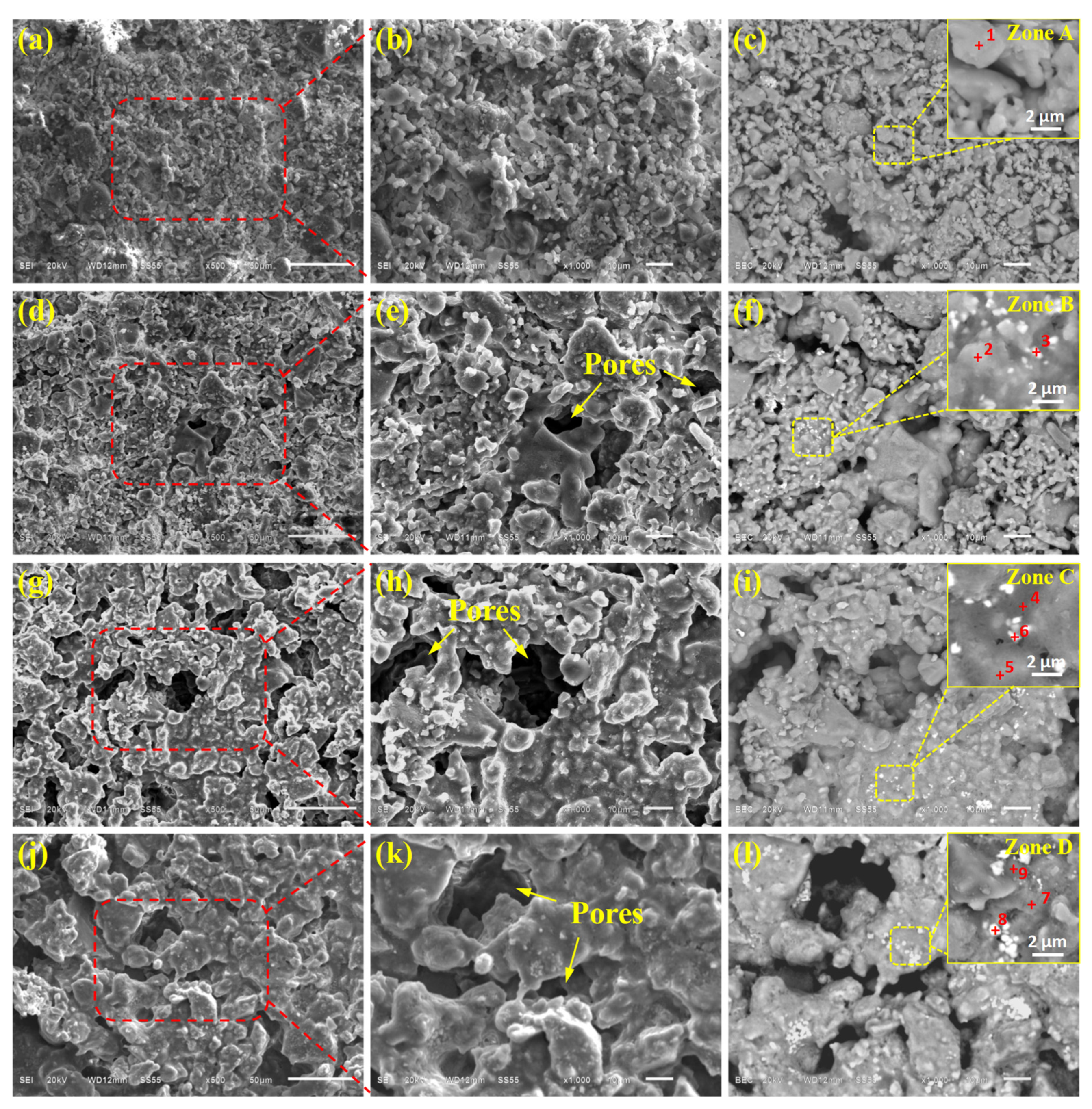

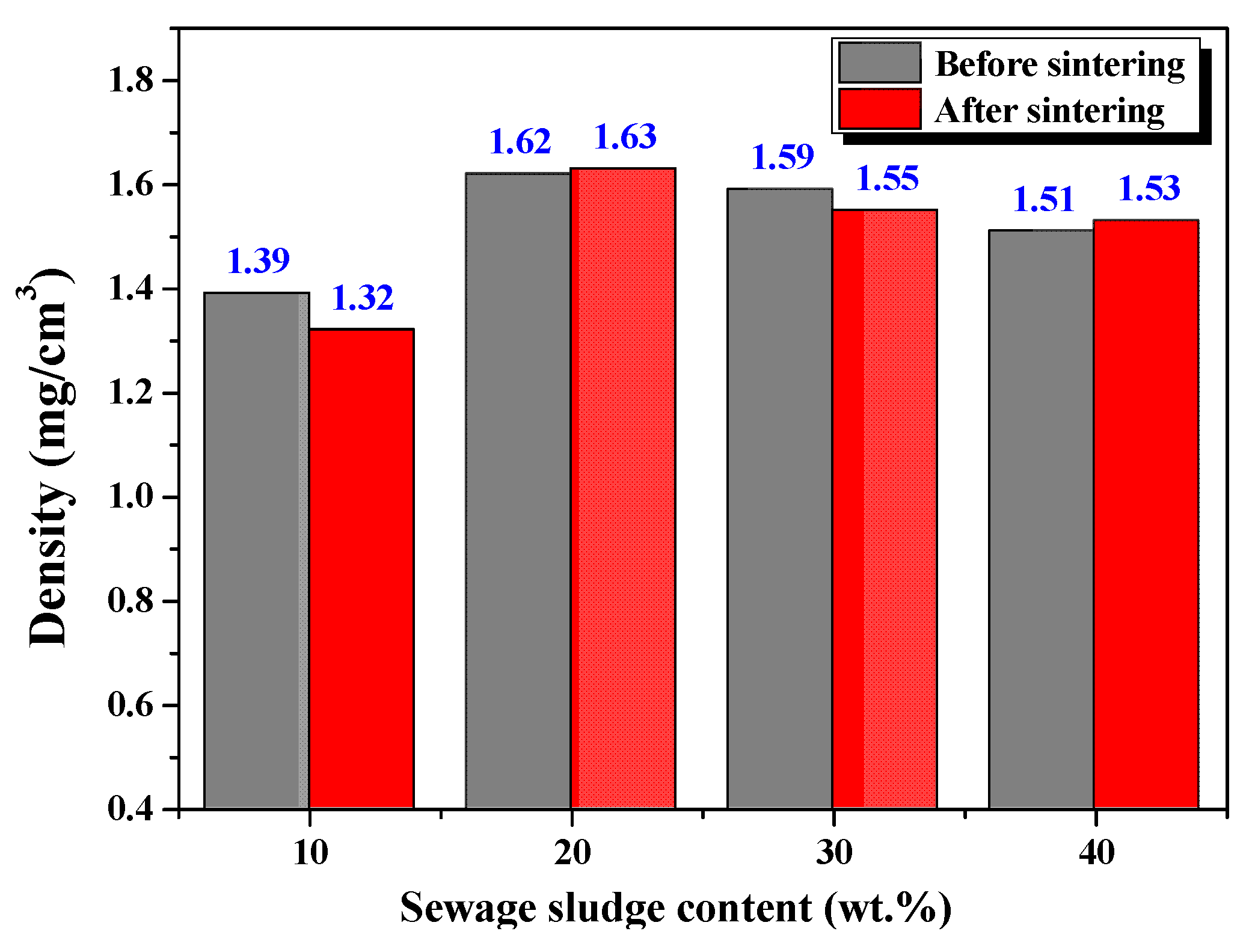
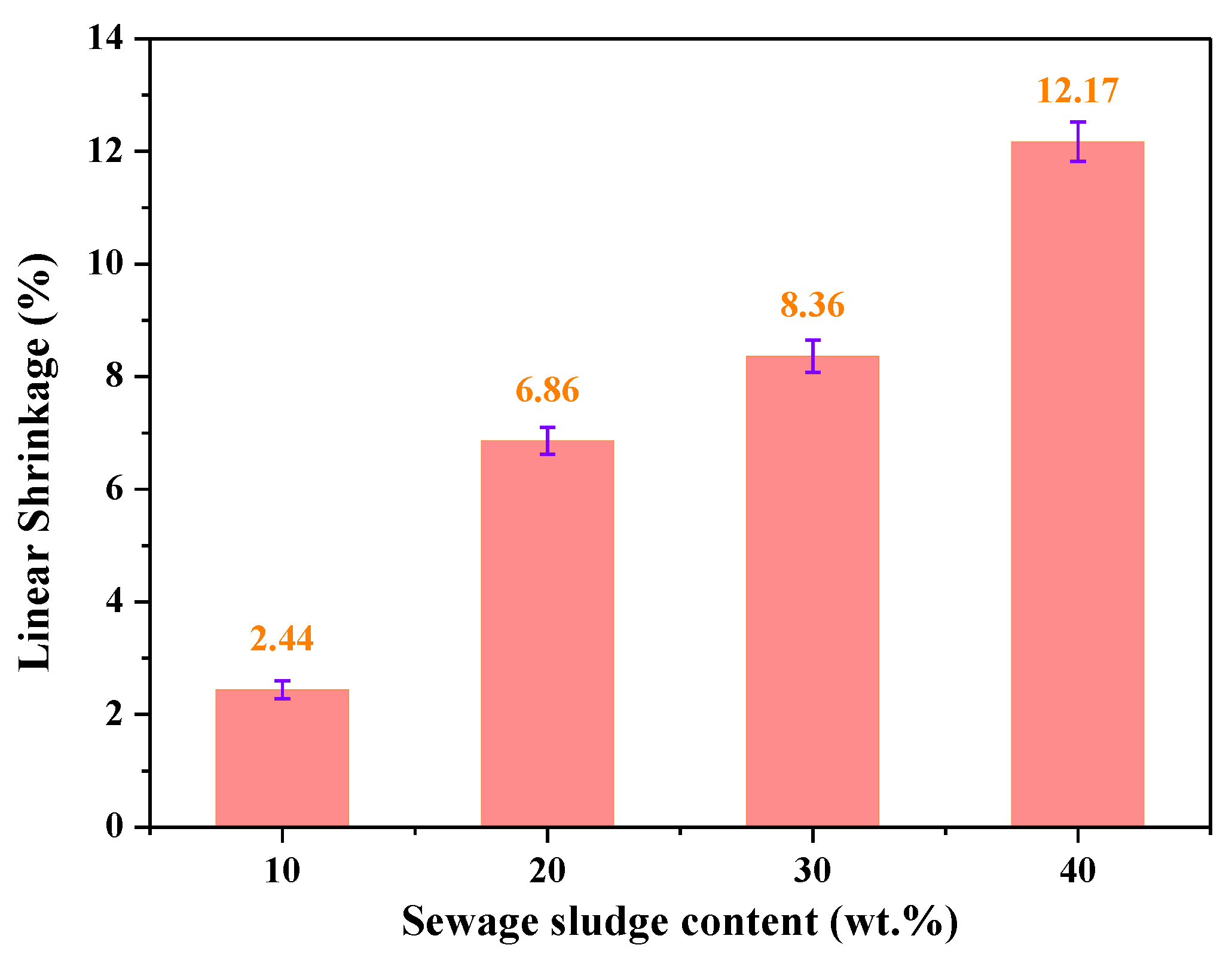
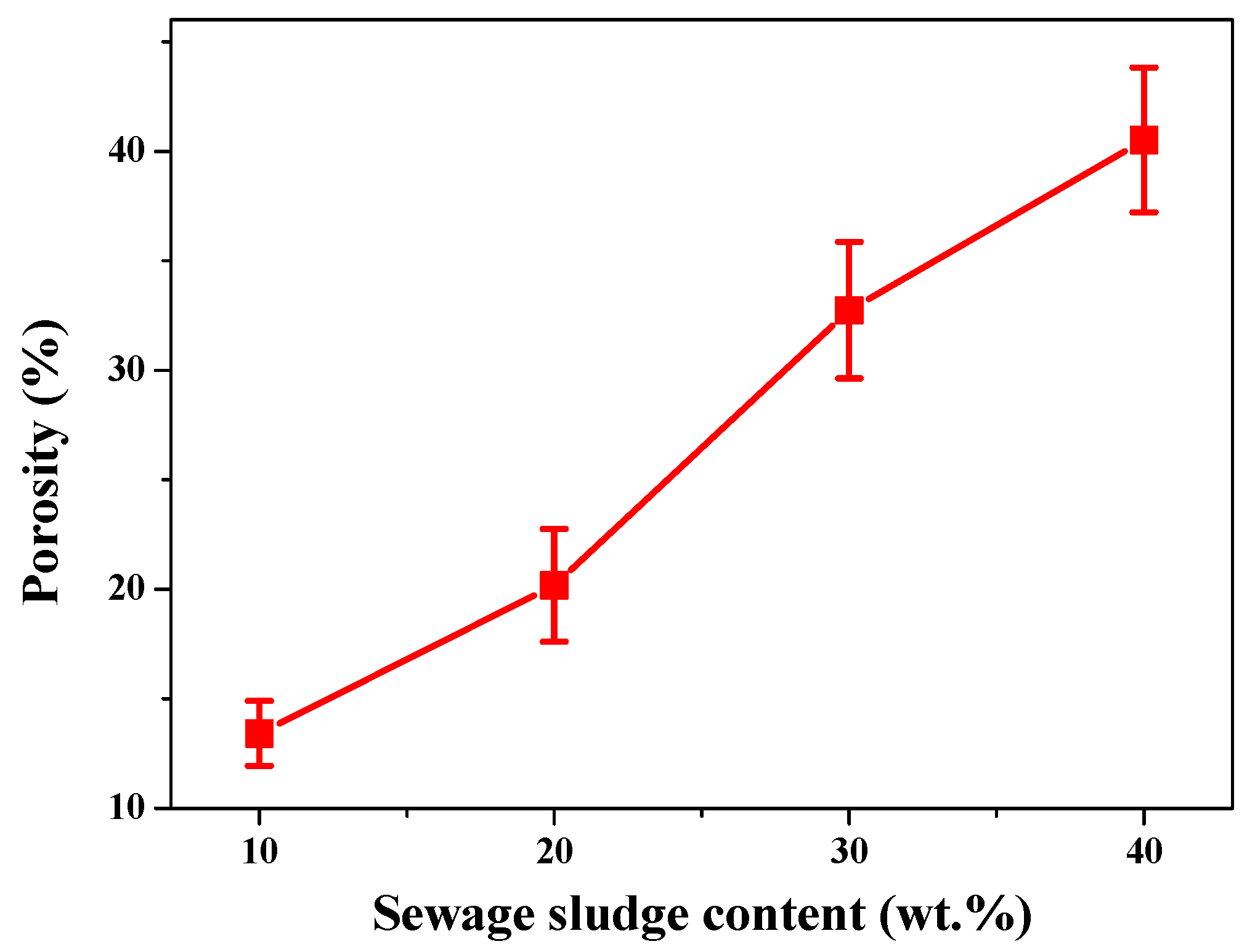
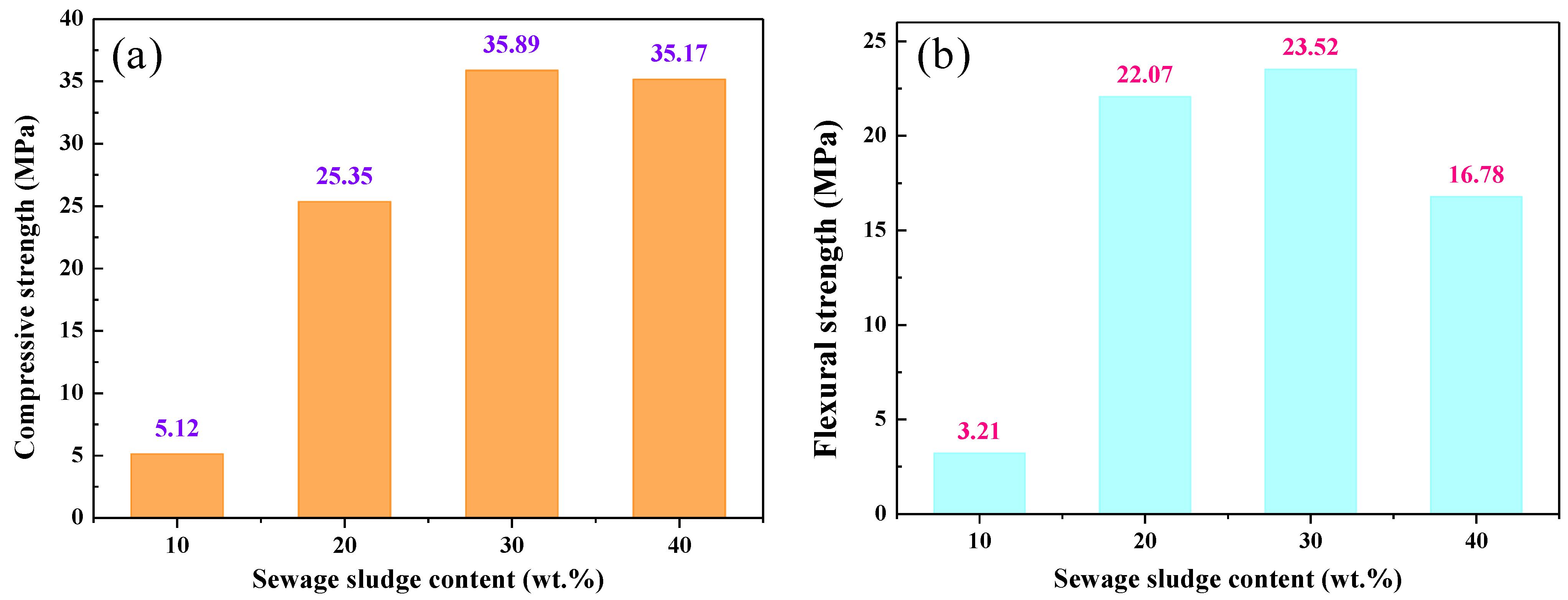
| Material | Al2O3 | SiO2 | Fe2O3 | P2O5 | CaO | MgO | K2O | Na2O | TiO2 | Cr2O3 | ZnO | Other | LOI |
|---|---|---|---|---|---|---|---|---|---|---|---|---|---|
| Sewage sludge | 16.42 | 34.84 | 12.37 | 18.65 | 4.26 | 2.07 | 2.75 | 1.61 | 0.47 | 0.21 | 0.25 | 6.56 | 37.64 |
| Kaolin | 42.53 | 53.82 | 0.73 | - | - | - | - | - | 1.24 | - | - | 1.68 | 15.21 |
| Sample | S1 | S2 | S3 | S4 |
|---|---|---|---|---|
| Sewage sludge | 10 | 20 | 30 | 40 |
| Kaolin | 90 | 80 | 70 | 60 |
| Binder (methylcellulose solution) | 10 | |||
| No. | Element Composition (wt.%) | Mineral Phases | ||||||||||
|---|---|---|---|---|---|---|---|---|---|---|---|---|
| O | Al | Si | Ca | Mg | Ti | Fe | Zr | P | Na | K | ||
| 1 | 68.85 | 19.73 | 16.06 | - | - | - | 0.56 | 0.79 | - | - | - | Mullite (3Al2O3·2SiO2) + Quartz (SiO2) |
| 2 | 63.34 | 14.38 | 14.16 | - | - | - | 1.38 | - | 1.05 | - | - | Mullite (3Al2O3·2SiO2) + Quartz (SiO2) |
| 3 | 45.26 | 9.38 | 8.29 | 0.64 | - | 0.47 | 34.30 | 1.65 | - | - | - | Hematite (Fe2O3) |
| 4 | 63.34 | 11.24 | 18.12 | 1.40 | 0.45 | - | 1.76 | - | 1.84 | 0.91 | 0.93 | Sillimanite (Al2SiO5) + Quartz (SiO2) |
| 5 | 69.56 | 13.37 | 12.28 | 0.57 | 0.44 | - | 1.19 | 0.74 | 0.60 | 0.88 | 0.37 | Mullite (3Al2O3·2SiO2) + Quartz (SiO2) |
| 6 | 46.31 | 9.43 | 8.21 | 0.72 | - | 0.45 | 34.35 | 1.63 | - | - | - | Hematite (Fe2O3) |
| 7 | 46.51 | 21.09 | 24.38 | 0.97 | - | 5.14 | 1.90 | - | - | - | Sillimanite (Al2SiO5) + Quartz (SiO2) | |
| 8 | 42.83 | 8.81 | 8.19 | - | - | 1.54 | 36.42 | 2.20 | - | - | - | Hematite (Fe2O3) |
| 9 | 53.37 | 21.45 | 18.27 | 1.30 | 0.43 | - | 1.73 | - | 1.81 | 0.80 | 0.63 | Mullite (3Al2O3·2SiO2) + Quartz (SiO2) |
| Waste Raw Materials | Product | Density (mg/cm3) | Shrinkage (%) | Porosity (%) | Compressive Strength (MPa) | Ref. |
|---|---|---|---|---|---|---|
| Sewage sludge; pure clay body | Clay bricks | - | 0.88–1.07 | - | 6.20–17.85 | [3] |
| Sewage sludge; oven slag; fly ash | Clay bricks | 2.14–3.38 | 2.82–10.98 | 11.87–44.68 | 2.26–31.67 | [13] |
| Municipal sewage sludge; clay; rice husk ash; Na2CO3 | Thermal insulation bricks | 1.25–1.55 | - | 36.19–44.31 | 4.71–13.59 | [18] |
| Municipal sewage sludge; clay; silica fume; fly ash | Thermal insulation bricks | 1.34–1.55 | - | 34.20–41.45 | 5.90–23.50 | [19] |
| Sewage sludge; kaolin | Ceramic bricks | 1.32–1.63 | 2.44–12.17 | 13.27–40.51 | 5.12–35.89 | This work |
Publisher’s Note: MDPI stays neutral with regard to jurisdictional claims in published maps and institutional affiliations. |
© 2022 by the authors. Licensee MDPI, Basel, Switzerland. This article is an open access article distributed under the terms and conditions of the Creative Commons Attribution (CC BY) license (https://creativecommons.org/licenses/by/4.0/).
Share and Cite
Zhang, X.; Jiao, Y.; Yu, L.; Liu, L.; Wang, X.; Zhang, Y. Effect of Sewage Sludge Addition on Microstructure and Mechanical Properties of Kaolin-Sewage Sludge Ceramic Bricks. Coatings 2022, 12, 944. https://doi.org/10.3390/coatings12070944
Zhang X, Jiao Y, Yu L, Liu L, Wang X, Zhang Y. Effect of Sewage Sludge Addition on Microstructure and Mechanical Properties of Kaolin-Sewage Sludge Ceramic Bricks. Coatings. 2022; 12(7):944. https://doi.org/10.3390/coatings12070944
Chicago/Turabian StyleZhang, Xuan, Yang Jiao, Laihao Yu, Lili Liu, Xidong Wang, and Yingyi Zhang. 2022. "Effect of Sewage Sludge Addition on Microstructure and Mechanical Properties of Kaolin-Sewage Sludge Ceramic Bricks" Coatings 12, no. 7: 944. https://doi.org/10.3390/coatings12070944
APA StyleZhang, X., Jiao, Y., Yu, L., Liu, L., Wang, X., & Zhang, Y. (2022). Effect of Sewage Sludge Addition on Microstructure and Mechanical Properties of Kaolin-Sewage Sludge Ceramic Bricks. Coatings, 12(7), 944. https://doi.org/10.3390/coatings12070944







